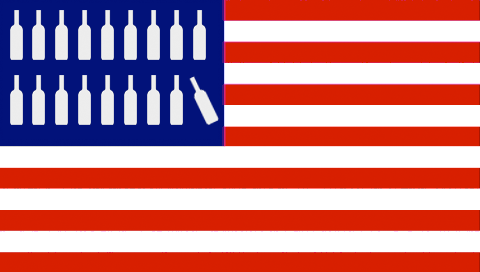
By Jim Boyce | So, a fellow country put a 15% tariff on your wines. That’s not a nice way to start the week, is it? Then again, it depends on who is tariffing (word?) and who is being tariffed (another word?). In the case of China targeting U.S. wines, here are ten quick takes:
1. The amount of U.S. wine involved is small. The U.S. only exports about 12.5% of production and, in 2017, only 3.7% of those exports went to China. That means about 0.4% of total production or 1 out of every 250 bottles.
2. As perspective, the U.S. exported six times more wine, by value and volume, to Canada.
3. But the tariff attracts attention because wine is tangible. Mention a steel tariff and I imagine huge coils of shiny metal illuminated by a smelter glow in some rough part of America. But wine? I can hold a bottle. And it’s going to cost rmb115 instead of rmb100? Nooooo!
4. Also, the amount of U.S. wine in China has shrunk. U.S.-based Wine Institute puts exports to China at 16.1 million liters in 2011 versus 14.2 million liters in 2017. China Customs stats show the U.S. share of imported bottled wine slid from 5% in 2011 to 2% in 2017. This when the overall market more than doubled and the U.S. faced no extra tariff. More details here.
5. Then again, the issue in China is often less about current buyers and more about potential buyers, the dream of moving toward a market where a billion people one day vociferously scream for Screaming Eagle.
6. That doesn’t mean the tariff won’t hurt right now. One China-based distributor told me this afternoon she has a container of U.S. wines arriving at port tomorrow and has fingers crossed it gets through sans extra tariff.
7. But it will be less painful than expected, in part because U.S. wine has some price insulation. You don’t see it in the bargain bin, or listed online as the cheapest option. Like New Zealand wines, U.S. labels cost a bit more.
8. I think U.S. wine fans understand this. France is the top source of wine but a huge amount is tied to status—gifting and entertaining. I believe a higher proportion of people U.S. wine buyers do so for reasons of taste. Maybe they visited or worked or studied in the U.S., or are wine aficionados, but they seek these labels. You often hear this from people who do U.S. wine promotion in China and talk about the move to “premiumization”, with a focus on value over volume.
9. I would argue there is even more price insulation with the very best U.S. wines. This brings us to the Hong Kong duty free factor. Wine Institute reported exports of 9.4 million liters to Hong Kong in 2017 (versus 14.2 million for China) worth USD118.8 million (versus USD78.7 million for China). Many of those pricey wines make their way to continental China. Let’s see if people who spend rmb1,000 for a bottle will balk at, say rmb1,150.
10. A bigger worry is the tariff getting tied to nationalism, that consumers, retailers and distributors turn their backs on U.S. wines as a political point. We saw this happen to South Korean products and it had a major impact, although, as noted, U.S. wine volume is small.
This isn’t meant to say the tariff is inconsequential. The U.S. faces wine competitors who have China free trade deals, including Chile, New Zealand and Australia. Paying an extra 15% alongside the current 14% tariff is an extra burden.
But China is a small market where U.S. wines carry a premium compared to those of many other nations and attract buyers who are less price sensitive than those simply seeking the cheapest bottle. It’s probably best to chill out—with a bottle of Schramsberg bubbly, Twomey Merlot or Hermann J Weimer Riesling—and figure out how get more wine fans trying those tasty U.S. wines.
Follow Grape Wall on Facebook and Twitter. Sign up for the China wine newsletter below. Also check out sibling sites Beijing Boyce and World Baijiu Day.
Grape Wall has no sponsors of advertisers: if you find the content and projects like World Marselan Day worthwhile, please help cover the costs via PayPal, WeChat or Alipay.
Sign up for the free Grape Wall newsletter here. Follow Grape Wall on LinkedIn, Instagram, Facebook and Twitter. And contact Grape Wall via grapewallofchina (at) gmail.com.

Leave a Reply
You must be logged in to post a comment.